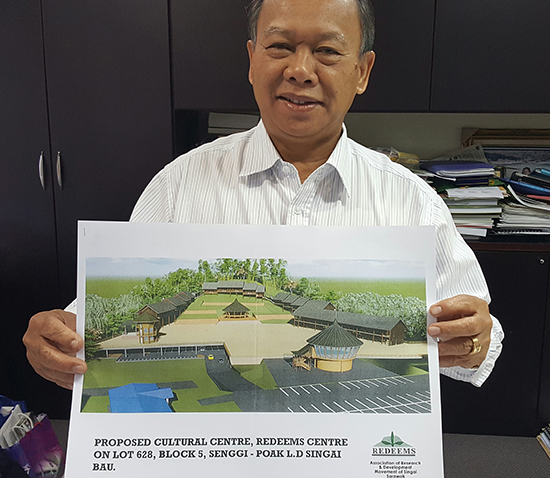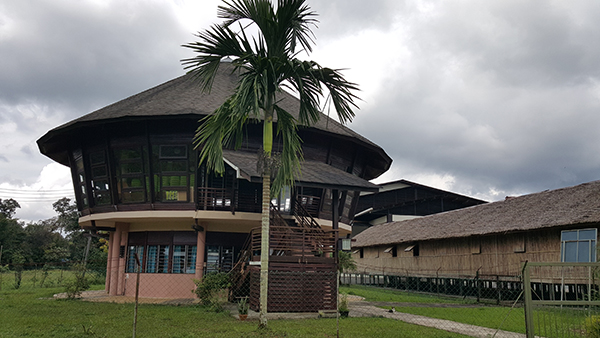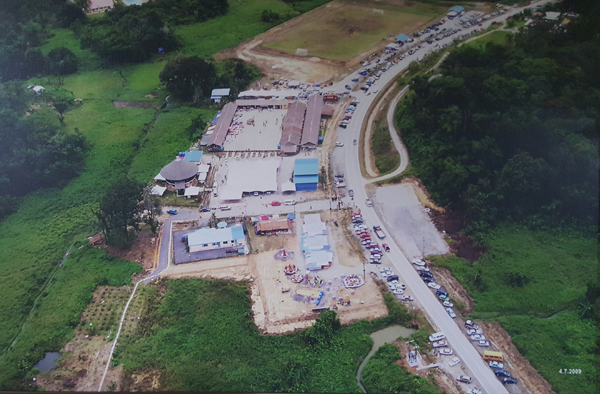
Nansian unveils the new design of the proposed Bidayuh Cultural Village.
FROM a small community-based association, it has grown by leaps and bounds in terms of assets to distinguish itself as one of the most successful organisations of a similar ilk in the state.
Even taking into account non-profit success, the Research and Development Movement of Singai (Redeems) has an enviable record to show.
Non-profit success may be measured by inputs, describing the quantum of resources, both financial and non-financial such as volunteer time, materials and equipment, among others, which are used to conduct social and physical activities or development.
Redeems not only has the land but also a multipurpose hall for big urban functions and events, an indoor sports hall, a football field, a Baruk library and ample parking space for various types of vehicles – all available at the Redeems Centre, strategically located at one of the Singai gateways in Kampung Apar, and also the border between Singai and the Chinese area.
Well-designed for the benefit of not only its members and community but also others wishing to use it, the Centre today has become the face of Singai and a notable landmark of Bau.
Thanks to its continuous annual social and festive programmes, especially the Gawai Carnival Redeems, this organisation of humble beginnings has been able to showcase the rich Bidayuh cultures, traditions and heritage.
The carnival to promote tourism and further foster inter-racial goodwill, has been growing in popularity since its inception in 2006. For years, it has been playing a significant role in promoting and reflecting a genuine culture of Malaysian and Bornean native festivals and sports, particularly for the Bidayuh tribe.
The rural setting in which these programmes are held, is also seen as a fitting avenue to strengthen cooperation, unity and understanding among the communities involved as well as to create goodwill among the event participants and visitors.
Because of its success, Redeems can be emulated as an experimental model or prototype of community development, especially in organising the typically small native community in a contemporary manner to complement the efforts of the government — and others — in helping the community catch up to the other more progressive communities.

The Baruk Library.
More contributions
In fact, Redeems has what almost every small community association longs for. Despite having registered notable success, it still aims to contribute more, especially in providing facilities and infrastructure, not just for its members but also for the community at large.
According to the Master Plan and model for the Redeems Centre, implementation of facilities and amenities will be carried out as and when funds are available.
The main project components, as recorded in the book launched by Head of State Tun Pehin Sri Abdul Taib Mahmud during the Gawai Carnival Redeems last year, consist of the most needed facilities for the community’s physical, mental and spiritual development.
These include a multipurpose community hall, an indoor sports hall, a mini sports stadium (football field and running track), a cultural centre, a commercial block of five shophouses, an administrative block, a preschool block, the Baruk library, public car parks and outdoor sports courts. The biggest and most anticipated project is the proposed Bidayuh Cultural Village at the Redeems Centre.
Taib mooted the idea after noting the growing popularity of the carnival while officiating at the Gawai Carnival Redeems in 2009. Following his suggestion and encouragement, Redeems president Datuk Peter Nansian Ngusie did a project paper on the proposed centre, estimated to cost RM8 million, and brought it up to the Prime Minister for funding consideration.
Datuk Seri Najib Tun Razak who liked the proposal and supported it as a tourism project to help promote cultural diversity in Malaysia, pledged a federal grant of RM4 million.
Former Deputy Prime Minister Tan Sri Muhyiddin Yassin also pledged RM2 million when he was the special guest at Gawai Carnival Redeems 2014.
At the event, Muhyiddin also suggested to the Chief Minister for the state government to contribute RM2 million so that Redeems would have a total of RM8 million — when all the pledges were honoured – to kick-start the project.
The design of the Bidayuh Cultural Centre comprises 38 longhouses, a Baruk stage for open-air performances and commercial space on the first floors of the longhouses, fronting a huge tonyu (platform) which serves as a festival ground. The longhouses will double as village-stays for tourists and visitors.
A car park is planned on the covered groundfloor for about 250 vehicles. The parking space can also be used for exhibitions and a Sunday market, complete with public toilets.

The old Redeems Centre.
Design alterations
According to Nansian, some changes have been made to the old design to enhance the essence of the Bidayuh kampung setting. He said with the new design, it was proposed to rename the village the Bidayuh Cultural Village.
“We are planning to name each housing unit at this village after the various Bidayuh clans in Sarawak,” he revealed.
Among the clans are the Bisingai, Bijagoi, Bisadung, Biperoh, Bisapug, Bianah and Tibia.
Nansian said cost of the cultural village would be higher based on the new design.
“It’s about RM11 million in all which means I have to find another RM3 million for the project to take off,” he added.
The proposed Bidayuh Cultural Village will be Redeems’ most meaningful project for culture and tourism development. Both the state and nation will benefit from it over the long-term.
When fully operational, it will stimulate rural development, creating jobs and entrepreneurship for the rural people.
The facilities already available at the Redeems centre are:
Multi-purpose Hall: With a built-up area of 27 square feet or 150 feet x 180 feet, it is designed like a double-storey longhouse with an inner hall of 80 feet and outer hall on both sides of 20 feet x 100 feet and 30 feet x 100 feet respectively.
The groundfloor houses two squash courts, a kitchen, a store, a standard-size men and ladies’ changing rooms, a standard-size stage doubling as a store for keeping tables and chairs, three badminton courts, men and ladies’ public toilets, a VIP room and a VVIP holding room.
The first floor has a central common room, a 64-seat public gallery, a meeting room, an ICT-computer training room and five more rooms for administration, ladies, elders and veterans.
The outer and inner halls can seat 1,000 and 2,000 people respectively. The hall can also take up to a maximum of 150 dining tables. It has a traditional whole belia’ trunk staircase at both ends of the first-floor platform (tonyu) to make it look like a traditional longhouse.
The inner walls are covered with acoustic materials suitable for urban-standard functions and events.
Indoor Sports Hall: With a built-up area of 12,000 square feet or 100 feet x 120 feet, it has public toilets and changing rooms for both men and women, and a stage for informal performances, and sports like dart competitions.
The inner hall is used for a futsal court while the table tennis area is located in the outer hall. The hall can also be used for casual functions and events.
Car parks around the hall and between the hall and the football field are designed to cater for users of both facilities — hall and football field.
Baruk Library: Actually, this library was the first building to be put up at the Redeems Centre as a tourist product under the Culture, Adventure and Nature (CAN) tourism programme in 2002.
In the headhunting era, the Baruk or roundhouse of the Bidayuhs was used for lodging by the community’s headhunting warriors between their headhunting excursions. Rituals were also performed at the Baruk for the skulls of the enemies they captured, and kept in the roundhouse.
The Baruk walls are slanted outwards — to make it more difficult for the enemies to climb over, and if they did, their heads would be chopped and dropped onto the Baruk floor for easy collection.
Redeems’ Baruk, however, is used for meetings and small seminars on the main upper floor while the groundfloor is used for the community library with Internet access to reflect the lifestyle of the modern Bidayuhs.
One big factor that contributes to the success of a big community centre is the availability of ample car and bus parking facilities for big functions and events. Probably thousands of car and bus parking spaces are now available within the Redeems Centre site and at both sides of the main road fronting the centre.
Over 200 parking spaces will be created under the raised floor of the proposed Bidayuh Cultural Village. Thus, organising big events there should be very convenient for vehicle owners.
Nansian, whom many believe is the driving force behind the thriving organisation, said the modest achievements of Redeems had actually spurred it to do even more.
